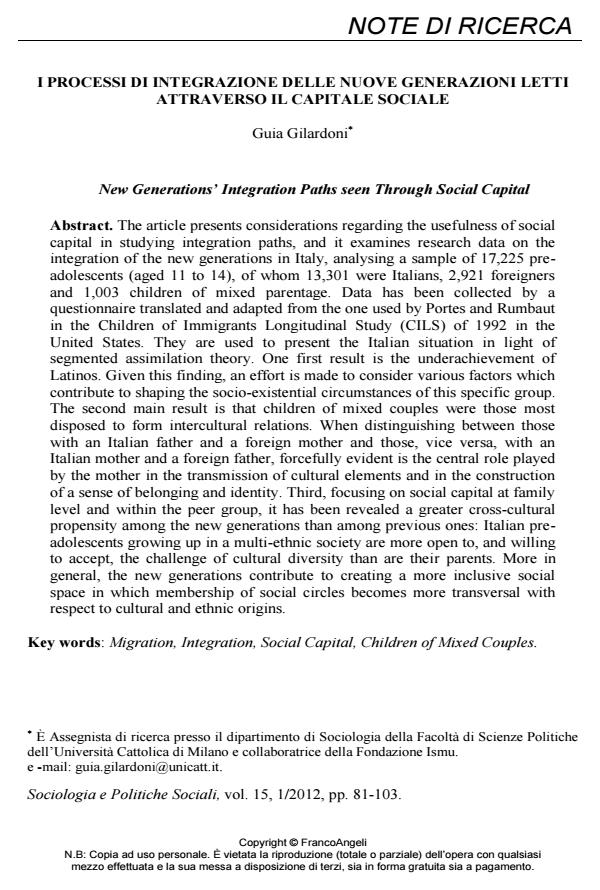I processi di integrazione delle nuove generazioni letti attraverso il capitale sociale
Titolo Rivista SOCIOLOGIA E POLITICHE SOCIALI
Autori/Curatori Guia Gilardoni
Anno di pubblicazione 2012 Fascicolo 2012/1 Lingua Italiano
Numero pagine 23 P. 81-103 Dimensione file 450 KB
DOI 10.3280/SP2012-001005
Il DOI è il codice a barre della proprietà intellettuale: per saperne di più
clicca qui
Qui sotto puoi vedere in anteprima la prima pagina di questo articolo.
Se questo articolo ti interessa, lo puoi acquistare (e scaricare in formato pdf) seguendo le facili indicazioni per acquistare il download credit. Acquista Download Credits per scaricare questo Articolo in formato PDF

FrancoAngeli è membro della Publishers International Linking Association, Inc (PILA)associazione indipendente e non profit per facilitare (attraverso i servizi tecnologici implementati da CrossRef.org) l’accesso degli studiosi ai contenuti digitali nelle pubblicazioni professionali e scientifiche
The article presents considerations regarding the usefulness of social capital in studying integration paths, and it examines research data on the integration of the new generations in Italy, analysing a sample of 17,225 preadolescents (aged 11 to 14), of whom 13,301 were Italians, 2,921 foreigners and 1,003 children of mixed parentage. Data has been collected by a questionnaire translated and adapted from the one used by Portes and Rumbaut in the Children of Immigrants Longitudinal Study (CILS) of 1992 in the United States. They are used to present the Italian situation in light of segmented assimilation theory. One first result is the underachievement of Latinos. Given this finding, an effort is made to consider various factors which contribute to shaping the socio-existential circumstances of this specific group. The second main result is that children of mixed couples were those most disposed to form intercultural relations. When distinguishing between those with an Italian father and a foreign mother and those, vice versa, with an Italian mother and a foreign father, forcefully evident is the central role played by the mother in the transmission of cultural elements and in the construction of a sense of belonging and identity. Third, focusing on social capital at family level and within the peer group, it has been revealed a greater cross-cultural propensity among the new generations than among previous ones: Italian preadolescents growing up in a multi-ethnic society are more open to, and willing to accept, the challenge of cultural diversity than are their parents. More in general, the new generations contribute to creating a more inclusive social space in which membership of social circles becomes more transversal with respect to cultural and ethnic origins.;
Keywords:Migration, Integration, Social Capital, Children of Mixed Couples.
Guia Gilardoni, I processi di integrazione delle nuove generazioni letti attraverso il capitale sociale in "SOCIOLOGIA E POLITICHE SOCIALI" 1/2012, pp 81-103, DOI: 10.3280/SP2012-001005